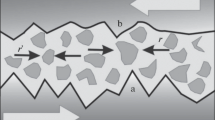Abstract
The time dependence of the aftershock energy is obtained for two strong earthquakes. An exponential form of the dependence indicates that aftershocks reflect relaxation processes in the source region.
Similar content being viewed by others
References
P. A. Aleksin, Zh. Ya. Aptekman, S. S. Arefiev, et al., “The Shikotan Earthquake of 1994: Epicentral Observations and the Source,” in Bulletin of the Federal System of Seismological Observations and Prediction of Earthquakes (MChS, RAN, Moscow, 1995), Special issue [in Russian].
Zh. Ya. Aptekman, A. V. Lander, C. Dorbath, and L. Dorbath, “Processes in the Focal Zone of the Spitak Earthquake from Data on Focal Mechanisms of Its Aftershocks,” Fiz. Zemli, No. 11, 86–95 (1991).
S. S. Arefiev, Epicentral Seismological Studies (Akademkniga, Moscow, 2003) [in Russian].
I. P. Bazarov, Thermodynamics (Vysshaya Shkola, Moscow, 1991) [in Russian].
C. Dorbath, L. Dorbath, Zh. Ya. Aptekman, et al., “Geometry of the Spitak Earthquake Source from Data of Detailed Aftershock Study,” Fiz. Zemli, No. 11, 96–105 (1991).
I. P. Gabsatarova, A. I. Zakharova, O. E. Starovoit, and L. S. Chepkunas, Catalog of the Racha, April 29, 1991, Earthquake and Its Aftershocks, Preprint, Iaieine, 1992.
A. P. Katok, Some Problems of Analysis of the Tajikistan Seismic Regime, Doctoral Dissertation, Moocow: Inst. Phys. Earth, Academy of Sciences of the USSR, 1967.
C. Kisslinger, “The Stretched Exponential Function As an Alternative Model for Aftershock Decay Rate,” J. Geophys. Res. 98(B2), 1913–1921 (1993).
L. D. Landau and E. M. Lifshitz, Theory of Elasticity (Nauka, Moscow, 1965) [in Russian].
F. Omori, “On Aftershocks of Earthquakes,” J. Coll. Sci. Univ. Tokyo 7, 111–200 (1884).
K. V. Pshennikov, “On the Origin of Shocks Following an Earthquake,” in Dynamics of the Earth’s Crust (Nauka, Moscow, 1965) [in Russian].
Yu. V. Riznichenko, Problems of Seismology: Selected Works (Nauka, Moscow, 1985) [in Russian].
L. L. Romashkova and V. G. Kossobokov, “Dynamics of Seismic Activity before and after the Strongest Earthquakes of 1985–2000,” in Computational Seismology (2001), Vol. 32, pp. 162–189 [in Russian].
V. B. Smirnov and A. V. Ponomarev, “Seismic Regime Relaxation Properties from In Situ and Laboratory Data,” Fiz. Zemli, No. 10, 26–36 (2004) [Izvestiya, Phys. Solid Earth 40, 807–816 (2004)].
T. Utsu, “A Statistical Study on the Occurrence of Aftershocks,” Geophys. Mag. 30, 521–605 (1961).
T. Utsu, Y. Ogata, and R. S. Matsu’ura, “The Centenary of the Omori Formula for a Decay Law of Aftershock Activity,” J. Phys. Earth 43, 1–33 (1995).
S. D. Vinogradov, “Acoustic Observations of Rock Failure Processes in the Anna Mine (Czechoslovakia),” Izv. Akad. Nauk SSSR, Ser. Geofiz., No. 4, 501–512 (1963).
Author information
Authors and Affiliations
Additional information
Original Russian Text © S.D. Vinogradov, 2008, published in Fizika Zemli, 2008, No. 2, pp. 59–62.
Rights and permissions
About this article
Cite this article
Vinogradov, S.D. Aftershock sequences as evidence for relaxation processes in a region containing an earthquake source. Izv., Phys. Solid Earth 44, 138–141 (2008). https://doi.org/10.1134/S1069351308020031
Received:
Published:
Issue Date:
DOI: https://doi.org/10.1134/S1069351308020031




